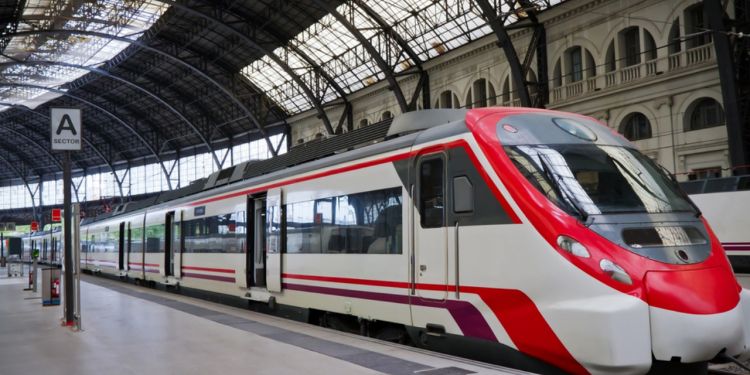Transportation in Spain

Spain has a highly developed and extensive public transportation system, from modern buses and metros to efficient tram networks and a vast railway infrastructure. The principal means of getting around the country is by road, accounting for the majority of personal and freight transport.
Airports and air transport in Spain
Spain is one of the top destinations in Europe, with the country´s airport authority, AENA operating 46 national and international airports. Most major cities have a main airport offering domestic and international flights.
Good to know:
You may discover promotional rates on some routes. Low-cost carriers such as Ryanair, EasyJet and Vueling advertise special offers from time to time.
Railways in Spain
Spain's train network encompasses more than 15,5000 kilometers of track, of which over 3,000 kilometers are for the ever-expanding system of high-speed (AVE - Alta Velocidad Española) trains. This rapid network is the longest in Europe and one of the longest in the world. It has been in service since 1992, and trains can travel up to 310 kilometers per hour, drastically cutting journey times. For example, the journey time from Madrid to Barcelona is around three hours, covering a distance of about 504 kilometers.
The Spanish rail network comprises long-distance, mid-distance and intra-city commuter routes making rail one of the most convenient and quickest ways to travel throughout Spain. You can also see parts of the country at a leisurely pace aboard special tourist trains.
When it comes to cost, short-distance trips tend to be on the affordable end of the spectrum, while long-distance journeys can be expensive. To get the best prices, reserve your tickets in advance at RENFE (Red Nacional de Ferrocarriles Españoles) train stations or online here.
Metros in Spain
There are well-developed underground (metro) systems in major Spanish cities such as Madrid, Barcelona, Seville and Malaga. They offer a quick and affordable way to get around, although they can become crowded during morning and evening rush hours. Even so, many commuters might find them a more convenient option than navigating the streets above by car or bus.
Madrid has the oldest and largest network, with more than 300 stations served by twelve metro lines, three Metro ligero tram lines and a special Ramal line (connecting Ópera and Principe Pío stations). Meanwhile, in Barcelona, there are 165 stations and eight lines, while Malaga boasts two lines and 19 stations.
Trams in Spain
Trams were once a common sight in Spanish cities until many networks were disbanded during the 1960s and '70s. However, since 1994 they have been making a comeback and are operating in several locations, including Madrid, Seville, Valencia, Alicante, Bilbao and Barcelona.
Buses in Spain
Spanish buses are a comfortable, cheap and reliable way to travel within and between towns, cities, villages and resorts. In the biggest metropolises, you'll find modern fleets with new and relatively new vehicles, but in some rural areas, you may have to make do with a ramshackle old bus. You can purchase tickets online, from station machines and ticket offices and once onboard. If you are traveling long distances by bus, it is a good idea to book your tickets in advance.
Taxis in Spain
If you would like to travel in more comfort and with fewer people, ride in a taxi. They operate in all major towns and cities and can be found outside airports and railway stations, near major points of interest and at main intersections. Flag them down or go up to a taxi rank. Typically, taxis in Spain are fitted with meters, and a card with the driver's details and taxi license number is clearly visible.
All licensed taxis in Spain level a standing charge and then charge per kilometer. If a taxi has no meter, you should agree on the fare with the driver before you get into the cab. Always beware of unlicensed cab operators who will rip you off.
Taxis have different colors in Spain depending on which city they are operating in. For example, Barcelona taxis are black and yellow, while taxis in Seville are white with a yellow stripe. Madrid taxis are white with a diagonal red band on the front door bearing the city's emblem.
Good to know:
Ride-hailing service Uber is steadily growing its presence in Spain, although it has met some opposition from taxi drivers.
Ride-sharing services such as BlaBla Car are also increasingly popular. They connect drivers and passengers willing to travel together and share the costs of the journey.
Renting a car in Spain
You can rent a car or a scooter if you have a valid driver's license. The minimum age for renting a car in Spain is 21, and for a scooter, it's 18. You will need to show your passport or national identity card, Spanish driver's license and a valid credit card.
Good to know:
The speed limit in Spain is fixed at 120 km/h on motorways and dual carriageways. Urban roads with a single lane in each direction have a limit of 30 km/h, while roads with two lanes in each direction in urban areas have a speed limit of 50 km/h.
The use of mobile phones while driving is strictly prohibited, including hands-free kits when an earpiece is worn.









